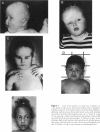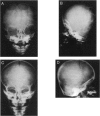Abstract
A contiguous gene syndrome due to deletions of the proximal short arm of chromosome 11 is described in eight patients belonging to four families. The main clinical features are multiple exostoses, enlarged parietal foramina, craniofacial dysostosis, and mental retardation. The patients have cytogenetic and/or molecular deletions of chromosome 11p11-p13. These deletions are located between the centromere and D11S914 in a region of approximately 20cM. The present study confirms the presence of a multiple exostoses gene on chromosome 11p. Furthermore, it suggests that the gene for isolated foramina parietalie permagna and genes associated with craniofacial dysostosis and mental retardation reside in the same chromosomal region.
Full text
PDF
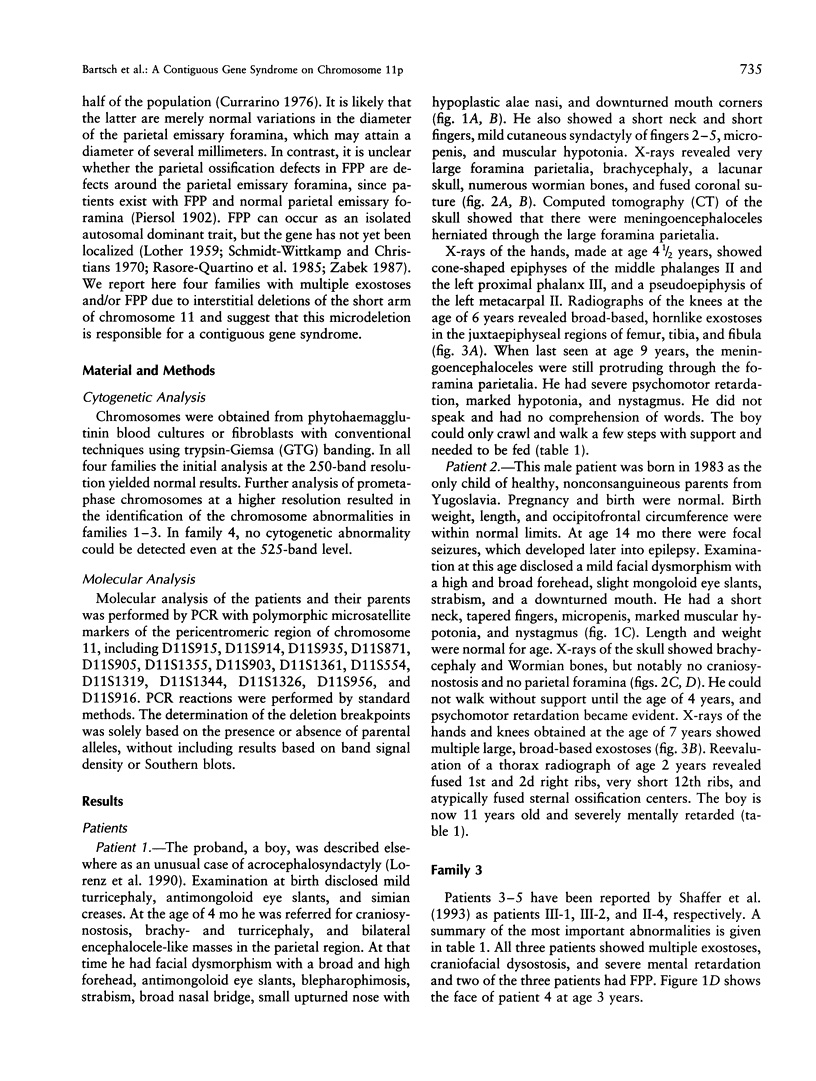


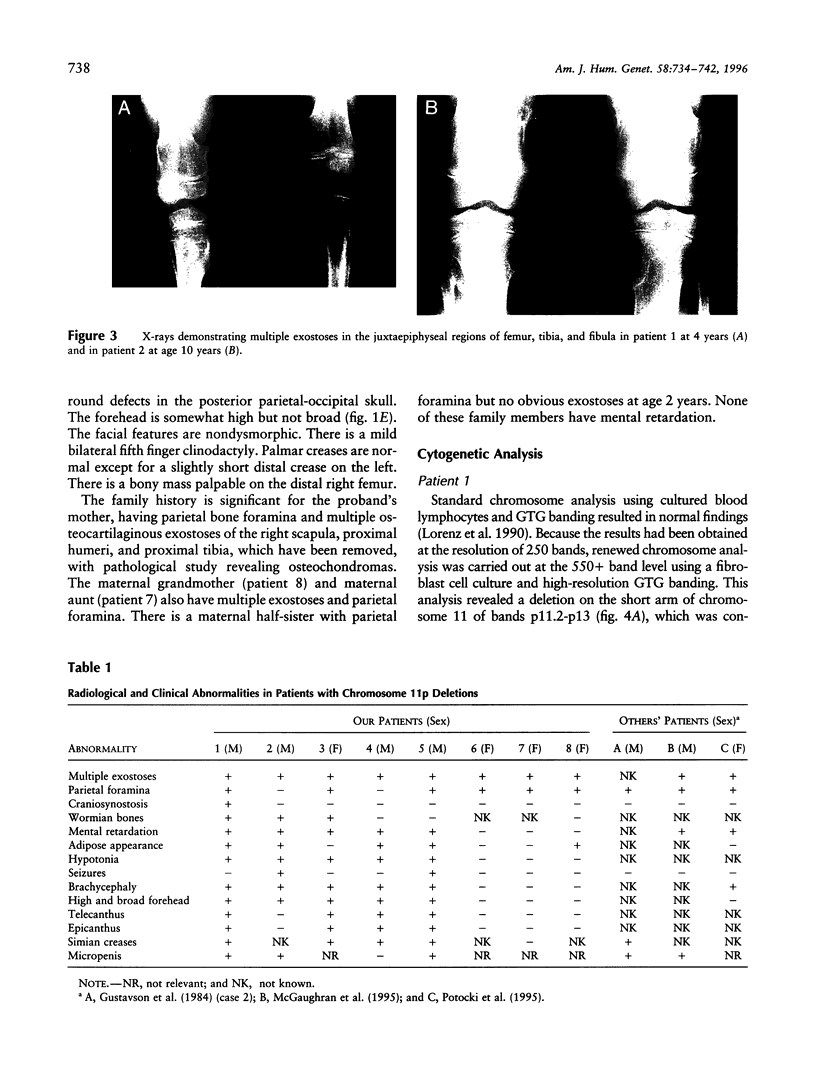
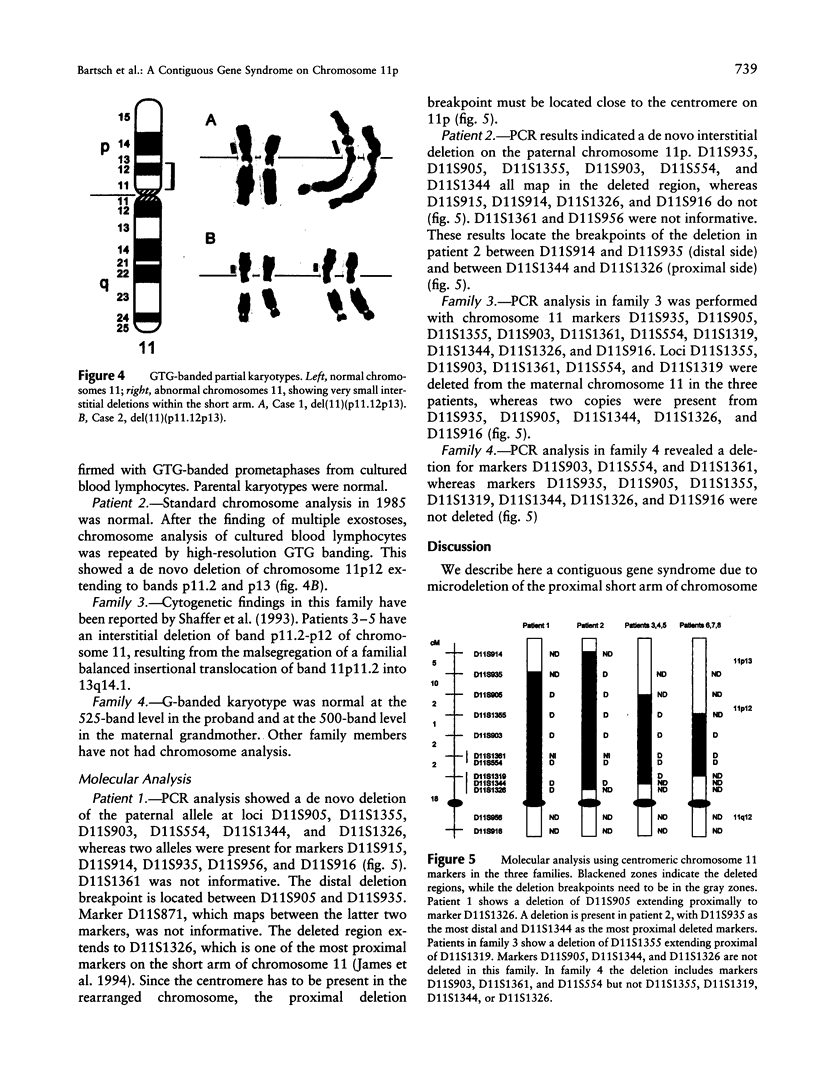

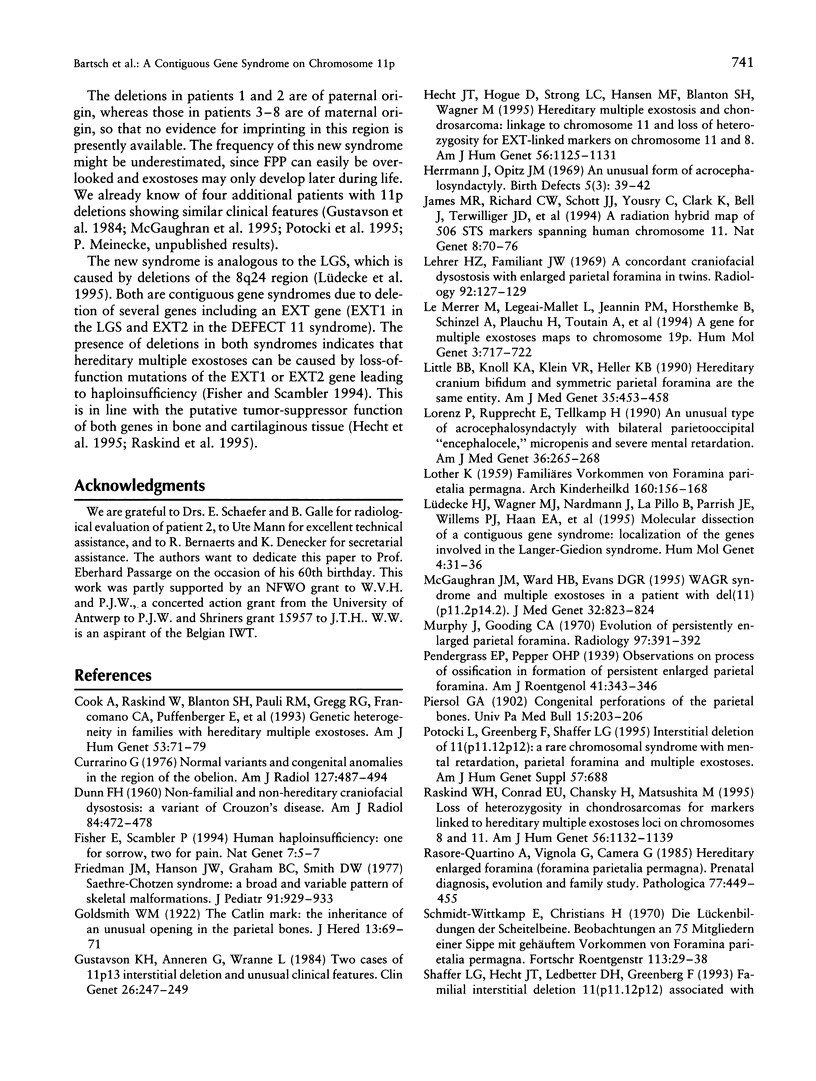

Images in this article
Selected References
These references are in PubMed. This may not be the complete list of references from this article.
- Cook A., Raskind W., Blanton S. H., Pauli R. M., Gregg R. G., Francomano C. A., Puffenberger E., Conrad E. U., Schmale G., Schellenberg G. Genetic heterogeneity in families with hereditary multiple exostoses. Am J Hum Genet. 1993 Jul;53(1):71–79. [PMC free article] [PubMed] [Google Scholar]
- Currarino G. Normal variants and congenital anomalies in the region of the obelion. AJR Am J Roentgenol. 1976 Sep;127(3):487–494. doi: 10.2214/ajr.127.3.487. [DOI] [PubMed] [Google Scholar]
- DUNN F. H. Nonfamilial and nonhereditary craniofacial dysostosis: a variant of Crouzon's disease. Am J Roentgenol Radium Ther Nucl Med. 1960 Sep;84:472–478. [PubMed] [Google Scholar]
- Fisher E., Scambler P. Human haploinsufficiency--one for sorrow, two for joy. Nat Genet. 1994 May;7(1):5–7. doi: 10.1038/ng0594-5. [DOI] [PubMed] [Google Scholar]
- Friedman J. M., Hanson J. W., Graham C. B., Smith D. W. Saethre-Chotzen syndrome: a broad and variable pattern of skeletal malformations. J Pediatr. 1977 Dec;91(6):929–923. doi: 10.1016/s0022-3476(77)80892-5. [DOI] [PubMed] [Google Scholar]
- Hecht J. T., Hogue D., Strong L. C., Hansen M. F., Blanton S. H., Wagner M. Hereditary multiple exostosis and chondrosarcoma: linkage to chromosome II and loss of heterozygosity for EXT-linked markers on chromosomes II and 8. Am J Hum Genet. 1995 May;56(5):1125–1131. [PMC free article] [PubMed] [Google Scholar]
- James M. R., Richard C. W., 3rd, Schott J. J., Yousry C., Clark K., Bell J., Terwilliger J. D., Hazan J., Dubay C., Vignal A. A radiation hybrid map of 506 STS markers spanning human chromosome 11. Nat Genet. 1994 Sep;8(1):70–76. doi: 10.1038/ng0994-70. [DOI] [PubMed] [Google Scholar]
- LOTHER K. [Familial occurrance of foramina parietalia permagna]. Arch Kinderheilkd. 1959;160:156–168. [PubMed] [Google Scholar]
- Le Merrer M., Legeai-Mallet L., Jeannin P. M., Horsthemke B., Schinzel A., Plauchu H., Toutain A., Achard F., Munnich A., Maroteaux P. A gene for hereditary multiple exostoses maps to chromosome 19p. Hum Mol Genet. 1994 May;3(5):717–722. doi: 10.1093/hmg/3.5.717. [DOI] [PubMed] [Google Scholar]
- Lehrer H. Z., Familant J. W. A concordant craniofacial dysostosis with enlarged parietal foramina in twins. Radiology. 1969 Jan;92(1):127–passim. doi: 10.1148/92.1.127. [DOI] [PubMed] [Google Scholar]
- Little B. B., Knoll K. A., Klein V. R., Heller K. B. Hereditary cranium bifidum and symmetric parietal foramina are the same entity. Am J Med Genet. 1990 Apr;35(4):453–458. doi: 10.1002/ajmg.1320350402. [DOI] [PubMed] [Google Scholar]
- Lorenz P., Rupprecht E., Tellkamp H. An unusual type of acrocephalosyndactyly with bilateral parietooccipital "encephalocele," micropenis, and severe mental retardation. Am J Med Genet. 1990 Jul;36(3):265–268. doi: 10.1002/ajmg.1320360302. [DOI] [PubMed] [Google Scholar]
- Lüdecke H. J., Wagner M. J., Nardmann J., La Pillo B., Parrish J. E., Willems P. J., Haan E. A., Frydman M., Hamers G. J., Wells D. E. Molecular dissection of a contiguous gene syndrome: localization of the genes involved in the Langer-Giedion syndrome. Hum Mol Genet. 1995 Jan;4(1):31–36. doi: 10.1093/hmg/4.1.31. [DOI] [PubMed] [Google Scholar]
- McGaughran J. M., Ward H. B., Evans D. G. WAGR syndrome and multiple exostoses in a patient with del(11)(p11.2p14.2). J Med Genet. 1995 Oct;32(10):823–824. doi: 10.1136/jmg.32.10.823. [DOI] [PMC free article] [PubMed] [Google Scholar]
- Murphy J., Gooding C. A. Evolution of persistently enlarged parietal foramina. Radiology. 1970 Nov;97(2):391–392. doi: 10.1148/97.2.391. [DOI] [PubMed] [Google Scholar]
- Raskind W. H., Conrad E. U., Chansky H., Matsushita M. Loss of heterozygosity in chondrosarcomas for markers linked to hereditary multiple exostoses loci on chromosomes 8 and 11. Am J Hum Genet. 1995 May;56(5):1132–1139. [PMC free article] [PubMed] [Google Scholar]
- Rasore-Quartino A., Vignola G., Camera G. Hereditary enlarged parietal foramina (foramina parietalia permagna). Prenatal diagnosis, evolution and family study. Pathologica. 1985 Jul-Aug;77(1050):449–455. [PubMed] [Google Scholar]
- SOLOMON L. Bone growth in diaphysial aclasis. J Bone Joint Surg Br. 1961 Nov;43-B:700–716. doi: 10.1302/0301-620X.43B4.700. [DOI] [PubMed] [Google Scholar]
- Schmidt-Wittkamp E., Christians H. Die Lückenbildungen der Scheitelbeine. Beobachtungen an 75 Mitgliedern einer Sippe mit gehäuftem Vorkommen von Foramina parietalia permagna. Fortschr Geb Rontgenstr Nuklearmed. 1970 Jul;113(1):29–38. [PubMed] [Google Scholar]
- Thompson E. M., Baraitser M., Hayward R. D. Parietal foramina in Saethre-Chotzen syndrome. J Med Genet. 1984 Oct;21(5):369–372. doi: 10.1136/jmg.21.5.369. [DOI] [PMC free article] [PubMed] [Google Scholar]
- Wu Y. Q., Heutink P., de Vries B. B., Sandkuijl L. A., van den Ouweland A. M., Niermeijer M. F., Galjaard H., Reyniers E., Willems P. J., Halley D. J. Assignment of a second locus for multiple exostoses to the pericentromeric region of chromosome 11. Hum Mol Genet. 1994 Jan;3(1):167–171. doi: 10.1093/hmg/3.1.167. [DOI] [PubMed] [Google Scholar]
- Wuyts W., Ramlakhan S., Van Hul W., Hecht J. T., van den Ouweland A. M., Raskind W. H., Hofstede F. C., Reyniers E., Wells D. E., de Vries B. Refinement of the multiple exostoses locus (EXT2) to a 3-cM interval on chromosome 11. Am J Hum Genet. 1995 Aug;57(2):382–387. [PMC free article] [PubMed] [Google Scholar]
- Young I. D., Swift P. G. Parietal foramina in the Saethre-Chotzen syndrome. J Med Genet. 1985 Oct;22(5):413–414. doi: 10.1136/jmg.22.5.413-a. [DOI] [PMC free article] [PubMed] [Google Scholar]
- Zábek M. Familial incidence of foramina parietalia permagna. Neurochirurgia (Stuttg) 1987 Jan;30(1):25–27. [PubMed] [Google Scholar]



